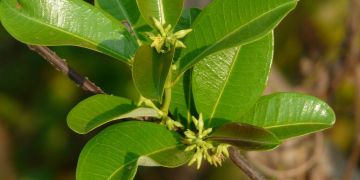It has likely been used for thousands of years by indigenous tribes of South America but was first introduced to Europe near the end of the Dark Ages. Today, it is still a popular supplement ingredient and medicinal treatment for a wide variety of internal and external health conditions.
Description of the Plant
This prickly vine is native to Mexico, the Caribbean and Central and South America. It climbs well and can grow to be over 50 yards long. The berries of sarsaparilla come in lustrous black, purple-blue and a red so rosy it could almost be called fuchsia. This beautiful fruit is popular among wild birds as well as humans. Certain varieties of sarsaparilla can also be found in India and China. The common name is derived from the Spanish zarzaparrilla which means "bramble" (from Basque sartzia "bramble"), and parrilla, meaning "little grape vine" a relatively accurate description of the outward appearance of the plant. Sarsaparilla is a member of the Liliaceae (Lily) family and includes over 300 unique species.
A sarsaparilla root typically measures between 6 - 8 feet in length. It is tuberous in shape and has no particular smell or taste. It has been used medicinally for hundreds of years by the people native to Central and South America who found that it relieved rheumatism, general physical weakness, sexual impotence, headaches, colds, joint pain and skin problems.
Uses
Medicinal uses
Sarsaparilla root is globally recognized for medicinal properties. Since it was first introduced to the Western world, sarsaparilla has been used to treat gout, gonorrhea, open wounds, arthritis, cough, fever, hypertension, pain, a lack of sexual desire, indigestion, and even certain forms of cancer. More serious conditions have also been treated with sarsaparilla root. In the Amazon, some tribes used it as a treatment for leprosy by ingesting it as well as using it externally.
Sarsaparilla first came to Europe in the 1400s as a medicine discovered in South America and brought back via boat. Europeans used the root to encourage sweating and urination as well as to purify blood, a common practice during the Dark Ages. During the 1800s, sarsaparilla was on the books in both Europe and the young United States for its blood purifying properties and recommended as a treatment for the sexually transmitted condition syphilis.
Nutrition
Sarsaparilla is also consumed for pleasure in drink and pickled form. Stores in some parts of Oceania stock a popular drink named simply Sarsaparilla that uses the plant to increase foaminess. In the past, it was also popular in the United States as part of a drink made with sassafras. In India, too, sarsaparilla is eaten for more than medicinal purposes. As well as soft drinks, southern Indians enjoy pickled sarsaparilla with curd rice.
Today, sarsaparilla roots is available most readily in health food stores. The capsules, tinctures and supplements of sarsaparilla usually include other herbs for a specific result. It is a common ingredient in hormone balancing, skin care and sex drive increasing natural products. These modern sarsaparilla products are primarily produced from plants grown in Latin America and China.
Active Ingredients
The studies that have been done on sarsaparilla as a medicinal herb suggest that the benefits come from antioxidant properties and plant sterols beneficial to human health. Sarsaparilla also contains flavonoids, a pigmentation chemical that gives many plants their leaf, stem, flower and even root color. In the past decade, flavonoids have garnered more widespread recognition for their use in treating autoimmune conditions and inflammation.
One of the most fascinating ingredients in sarsaparilla root are saponins, a chemical compound. Saponins, usually bitter to the taste, are named after soap because of the foam-like reaction they have when placed in water. In the plants where they originate, saponin chemical compounds help deter fungi and insects from eating their leaves. This could be one of the possible reasons that sarsaparilla has anti-fungal properties.
Preparation
The best way to prepare raw or dried sarsaparilla root is to boil it into an infusion and take a cup of it several times a day. With capsules and supplements, read the instructions on the bottle. Usually, it takes less than half a teaspoon of ground root powder to have the desired effect. In the case of tincture, half a teaspoon twice daily is a recommended dose.





